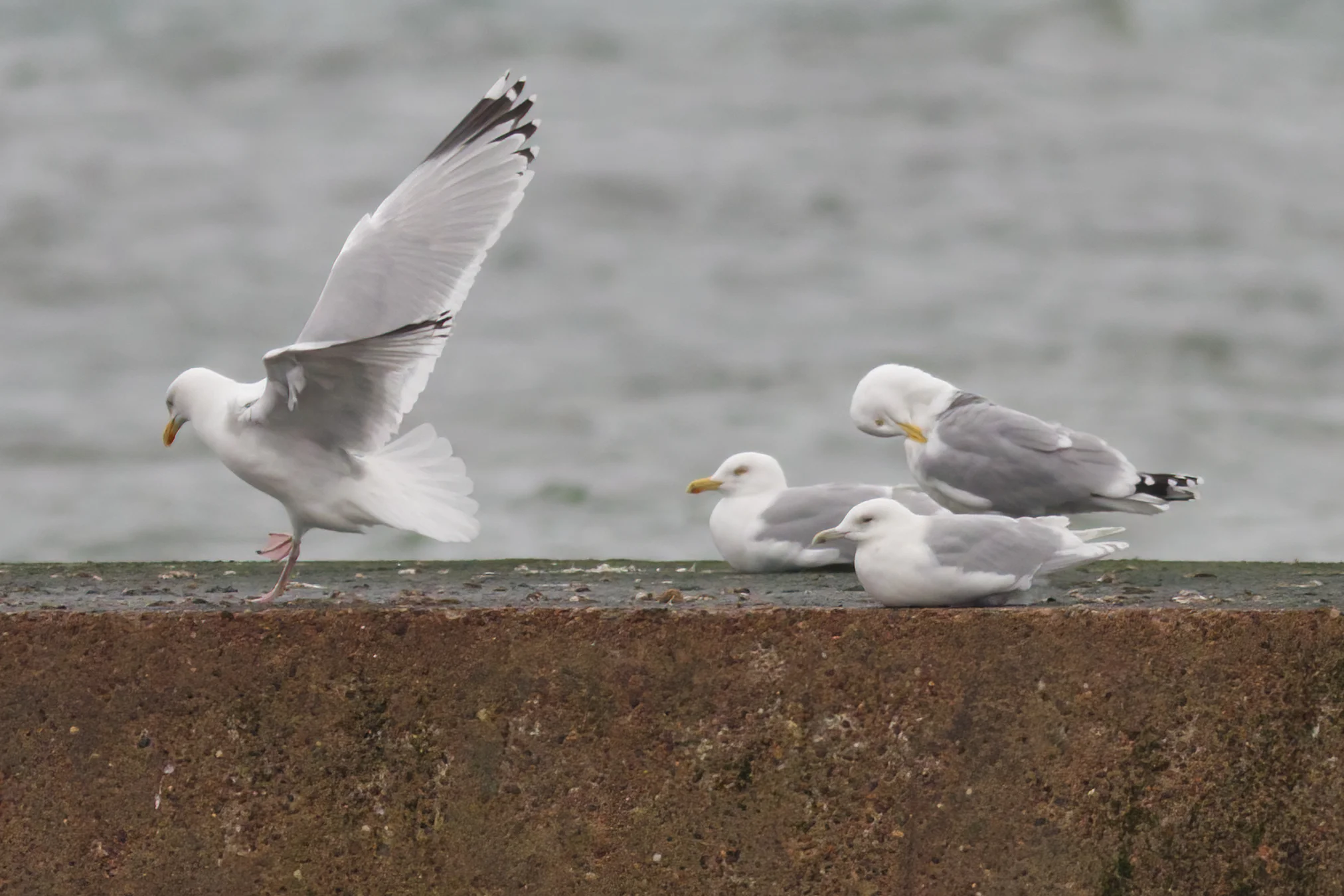As another year draws to a close, I saw several amazing birds in 2024, including four new species for my Cheshire & Wirral list, which currently has 299 species, and four new species for my BOU list, which currently has 539 species. These are a few of the year's highlights.The year began with the announcement that the BBRC had acknowledged Allan Conlins' and my observation of a Barolo shearwater off the North Wirral coast, after 13 years. Please click the following links to view Richard Smith's and my article:
Dee Estuary Birding read more>
Barolo Sighting read more>
Me and Allan all smiles after the Barolo shearwater sighting
All was quiet in the birding world until May 19th when an Indigo bunting was found in Whitburn, County Durham. Having missed the St Agnes bird on the Scilly Isles in late October 2020 by minutes, this was my second attempt. Two and a half hours later, after a good run, Peter kindly lets Jenna and me into his house where the Indigo is showing on his bird feeders. What a bird!
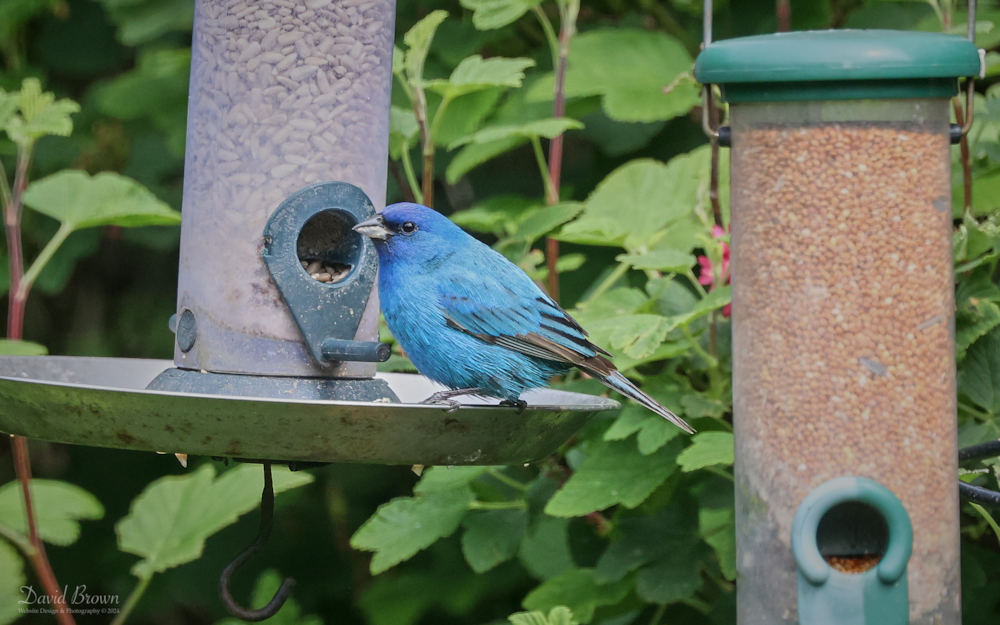 Indigo Bunting
Indigo Bunting
Visiting friends in late May on the way down to Birmingham, news broke that a Roseate tern had been found at Marsh Lane nature reserve, the bird showed well as soon as I arrived on site.

I also visited the county of Cambridgeshire and headed straight for Fens Drayton lakes where I managed to find the 1st summer Red-footed falcon perched up on top of a poplar tree. These are great birds and it was nice to catch up with this showy male, Cheshire is due one of these 🙏

Moving on from here, I drove to Ouse Fen RSPB where after a short walk the Great reed warbler could be heard singing away and eventually showed really well. I haven't seen one of these for years, so it was nice just to sit and watch this beauty on my own singing away. Two Bitterns flew out of the reed bed in front of me, which was also good to see.
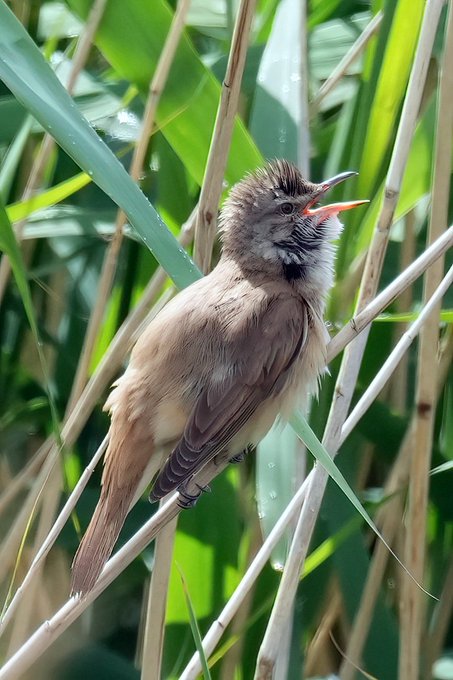
After great views, I drove back and called in at Paxton Pits on the way home where I had stunning views of Nightingale, two were seen and this finished off a good day's birding!
Early June was spent with friends in Oban, I called in at Inchinnan, Clyde on the way up and managed to connect with a Stone curlew that had been found, on arrival the weather conditions were appalling but the bird showed well on arrival.
This was the first record for Clyde since 1966
Other birds of note during the week were Golden eagle, White tailed Eagle, 2 Ospreys and a pair of Red-throated Divers on their breeding ground.
On the way home I called in at Loch Turret reservoir where I got cracking views of a Ring-billed gull.
On the 6th of July, news broke that a Caspian tern had been found at Sandbach flashes. This was a new bird for me in Cheshire and Wirral, having missed the Acre nook bird back in 2013 due to being on holiday.
 Acre Nook bird
Acre Nook bird
After a good run over to Sandbach and many a phone call on the way to see if the bird was still there, I arrived and got put straight on the bird by my good friend Fred Ferne, at last I had gripped this bird back, it had taken 11 years!
This was the 8th record for Cheshire and Wirral
Previous records:
2013 Acre Nook Sand Quarry 24th-29th July
1994 Neumanns Flash and Marbury 12th June
1992 Neumanns Flash and Marbury 30th-31st May
1988 Neumanns Flash 26th June
1988 Northwich 8th May
1986 Hilbre Island 31st May
1967 Witton Flashes, Great Budworth and Marbury 2nd-4th July
Visiting friends in Norfolk in July, I called in at Finningley in Nottinghamshire on the way and managed to connect with a Black winged pratincole that has been present for the last couple of weeks.

This was only my fourth Black winged pratincole I had seen in Britain, the last one was on the 4th May 2012 at Burton RSPB in Cheshire.
Over the next few days, I connected with a Glossy Ibis at Cley.

Having spent the weekend in Edinburgh in late July, I called in at Musselburgh lagoons on the way home to try and see the Stejneger's scoter again. On arrival, there were already birders on the bird, which was nice as I was in a rush to head home back south. The bird showed really well with a few Velvet scoters.

I had made the journey previously to see Stejneger's scoter in December 2023, the bird was accepted to the British list, click on the link below
At the beginning of August, whilst out and about in Norfolk with friends, we all called in at Snettisham RSPB to look for a White rumped sandpiper.
There were up to five White rumped sandpipers on the 5th on the North Norfolk coast, reported today, and three had been reported from this site.
As the tide eventually came in and wader numbers increased in the Wash, a birder called out that he had found one.
I had only seen one previously at St Mary's Island, Tyne and Wear, back in 2002, this is a bird that is well overdue in Cheshire and Wirral. I hadn't visited this site for a good ten years and just enjoyed the rest of the evening watching hundreds of waders in murmuration and watching the sun go down.
The next day I visited Cromer, this time of year is the place in Britain for seeing juvenile Caspian gulls in late summer. Geographically speaking, it makes sense. Cromer is situated at the north-eastern corner of one of England's most easterly counties. Directly to the east lies the coast of North Holland. It's perfectly positioned to be the first arrival point for juvenile Caspian gulls dispersing westwards from mid-July. Much in the way that south-east England seems to be the point for the first arriving Yellow-legged gulls a couple of weeks earlier. For anyone interested in gulls, Cromer comes highly recommended for unrivalled opportunities to study Caspian Gulls at point-blank range.
Four birds had been reported regularly throughout the week on the beach at Cromer so I visited with my good friend Owen Parsons. On arrival, it didn't take long to find our first juvenile Caspian gull, roosting on the beach.
As we were looking through the juvenile Herring gulls, a 1st summer Caspian gull appeared sitting on the rocks.
Then another bird appeared on the beach in front of us.

I couldn't believe how many Caspian Gulls were about, we connected with six individual birds, three 1st summers and three juvenile birds, but the adult bird eluded us after a good search of the area.
Owen papping away with a close Caspian Gull
A great evening's birding finished off with a pint watching the sun go down.
On the 11th August I called in at Lilbourne nature reserve as I was passing through Northamptonshire and got cracking views of a Lesser yellowlegs.
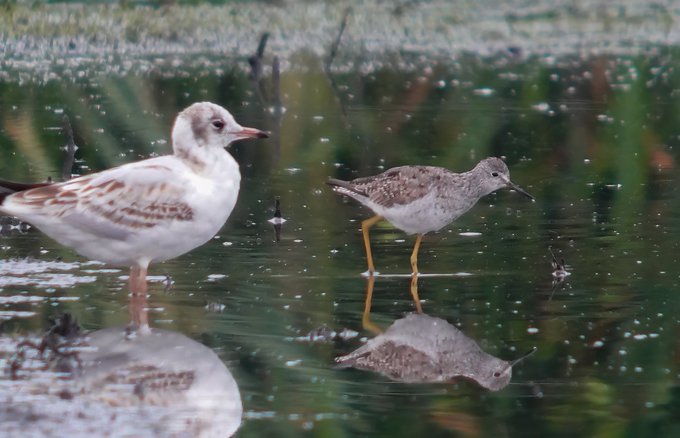
Apparently the last record of this species in Northamptonshire was 29 years ago! Other birds on site were Pectoral sandpiper,2 Green sandpiper and 6 Yellow wagtails.
On the 14th August, whilst passing Abberton reservoir in Essex with my good friend Owen Parsons, news broke that a Canvasback was showing well on the causeway. Owen needed the bird for Britain, so we decided to give it a go.
I had previously seen the Pennington flash bird in 2002(See below)
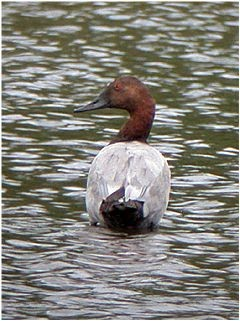 Pennington Flash Bird 2002
Pennington Flash Bird 2002
On arrival, the bird was showing really well on the causeway.
Other birds of note on site were Great white egret and 5 Garganey. Moving on from here, we called in at Dunwich Heath where we connected with another target bird that Owen had never seen before, the Dartford warbler.
It didn't take long as we were walking around to hear the first alarm call of a Dartford warbler. The bird was a young juvenile that proved elusive at first and then gave itself up and sat out in the open.
A superb end to a cracking afternoon's birding and Owen had two lifers on his list!
News broke late on the evening of the 18th, that Colin Wells had found an absolute MEGA of a bird at Burton RSPB, a Hudsonian godwit. I was away for the week, so there was nothing I could do if it was found. News came out at 9.00am in the morning, there was no sign of the bird, and then the dreaded happened, the MEGA alert went off, it was still there! This was a first for Cheshire and Wirral and one hell of a bird for our County and we don't often say that, I had seen one previously before down in Somerset in 2015.
I made my mind up I wasn't going as it was a good five hours away from home, so tried to get on with my day. Thankfully the bird flew, which would have been even worse if I had set off driving. News then came out that the bird had been seen earlier on Monday over at the Connah's Quay reserve. For the rest of the week people have been constantly looking for the bird, but there has been no sign of it.
Fast forward to this morning and the bacon's under the grill and the MEGA alert goes off," It's back", a crazy five minutes ensued and Jenna and I are in the car. A fifteen-minute drive and we were on site, walking rather quickly around to Border hide, and there it is roosting right in front of the hide. The bird eventually showed really well and then it opened up its wings, showing it's striking black on its undersides. What a bird and what a grip back after thinking the bird had gone!

The Hudsonian godwit is slightly smaller than our regular Black tailed godwits and much darker in plumage with a noticeable black underwing. They are a long distance migratory species that breeds at remote sites in northern Canada and winters in southern South America.
On the 21st of August Owen and I called in at a new site, Dickleburugh Moor, Suffolk. There had been a Temminck's stint present for a few days and a Wood sandpiper was now apparently on site.
Dickleburugh Moor
It didn't take long to find the Temminck's stint foraging only a few meters from the footpath and it showed really well.
A Wood Sandpiper also showed well on the opposite flood with 4 Ruff,2 Green sandpiper and a Hobby put in a low flight performance.
A lovely evening spent walking around this site and a cracking place for birds.
27th Aug
Owen and I called in at Ouse Fen RSPB on the 27th August in Cambridgeshire to try and connect with a Black Winged Stilt that had been reported. We had previously visited here in May to see a Great Reed Warbler, so we knew the site and where to look for the Stilt.
It didn't take long before we connected with the Black winged stilt, feeding at the back of Cell 10.
The Black Winged Stilt showed really well but was always on the move and then got flushed by a Marsh Harrier as it flew over low and the Stilt ended up flying to the back of the marsh. Other birds of note on Cell 10 were a Wood sandpiper, Greenshank, Ringed plover, Great white egret and a Eurasian Spoonbill.
On the 9th of September, having only seen four Purple Herons in Britain and being so close to the site, I called in and was lucky the bird was on show as soon as I arrived. This is a bird that is well overdue in Cheshire and Wirral, even though we have had four records in twenty years, none of them have been twitchable and have flown off, so this was a nice bird to catch up with and it showed really well.
Travelling to Norfolk on the 12th September, up to Norfolk, I called in at Wells Wood where an Icterine Warbler had been reported. Having parked the car up I made my way to the area and bumped into James Hanlon, who had seen the bird and pointed me in the right direction. It didnt take long before the bird showed foraging around in the trees with a Long Tailed Tit flock. I hadn't connected with an Icterine Warbler since 2022 on Shetland so it was nice to see and it showed very well in the Norfolk afternoon sun.

(C) J Hanlon
Icterine Warbler
I had one good sighting of the bird and then it became really elusive, probably due to the weather becoming very overcast. Other birds of note in the same area were a Wood Warbler and 2 Spotted Flycatchers.
Wood Warbler
Spotted Flycatcher
Great afternoons, birding and at last autumn is upon us!
With five sightings of South Polar Skua being seen off the Isles of Scilly in the last couple of months, my good friend John Pegden organised three Pelagics to try and see this species, twelve of us finally agreed to go across on the 24th August.
I met up with Dan Pointon, Mark Sutton and John Pegdan and we headed down late morning. The journey down was full of optimism and conversation that we could see this rare bird, better to be out at sea than sat at home thinking what if!. Anyway, we called in at Cape Cornwall late afternoon and we all got great views of a Melodious Warbler, only my fourth for Britain.

Melodious Warbler
Cape Cornwall in the evening sun
The evening was spent in Penzance at the local curry house after a long drive South.
We were all up at 6.30am and made our way down to the quay in Penzance where the dawn sun greeted us behind St Michael's Mount.
The Scillionian
All ready for the Pelagics
The crossing over to the Isles of Scilly produced 5 Cory's Shearwater,2 Great Shearwater, a Juvenile Sabine's Gull and a Sooty Shearwater.
Here are the summaries of what we saw over the next few days:
Day 1 Pelagic
14 miles SW of St Mary’s:170 Cory Shearwaters,10 Great Shearwaters,2 Great Skuas,12 European Storm petrels and 250+ Short Beaked Common Dolphins
Heading out of St Mary's
Great Shearwaters breed on Nightingale Island, Inaccessible Island, Tristan da Cunha and Gough Island. It is one of only a few bird species to migrate from breeding grounds in the Southern Hemisphere to the Northern Hemisphere.
No South Polar Skua this evening as we passed Bishop Rock lighthouse on the way back, we go again tomorrow
Day 2 Pelagic
Today, Me, Dan and Neil spent the morning walking around St Mary's.2 Great White Egrets and 2 Common Rosefinch were seen.
Dan and Neil
Dan found two Common Rosefinches by St Mary's airport, which showed well. We left St Mary's at 1pm for the next Pelagic.
Adrian, getting the bread in for the Pelagic from the local Co-Op
At sea, various locations:15 Great Shearwaters, Sooty Shearwater,2 European Storm Petrel,4 Great Skuas and a Balearic Shearwater
Great Skua
Coming back into St Mary's
The evening was spent with my mate Higgo who lives on the Islands having a few beers and a catch up.
Day 3 Pelagic
Wolf Lighthouse and return: 2 Juvenile Sabine's Gull, Arctic Skua,80 Cory’s Shearwater,20 Great Shearwater, Shearwater, Balearic Shearwater,3 European Storm Petrel, 40 Short-Beaked Common Dolphin.
Wolf Lighthouse
Juvenile Sabine's gulls breed in the Arctic and they migrate south to the Southern Hemisphere in the autumn, covering up 24,000 miles per year, the longest migration of any gull
Well, after three days of Pelagics, we headed home with no sighting of a South Polar Skua, we did have a feeding group of >300 large shearwaters just West of the Wolf, seemingly equal split Cory's/Great, from the Scillonian on the way home back to Penzance.
Pelagic's already booked for next year, WE"LL BE BACK!
On the 28th September, an elusive phyllosc had been present at Bempton Cliffs RSPB in East Yorkshire since Wednesday, it was initially thought to be an Arctic Warbler and then the bird turned into a "possible" Eastern Crowned Warbler. Things then developed and with some diligent work by a local birder(including recordings), the bird was actually a Pale-Legged Leaf Warbler.
News broke too late to set off so plans were made for an early morning start over to Bempton Cliffs. Owen, Jenna and I set off at 5.30am and arrived on site just before 9.00am, meeting up with the masses. We joined in with everyone peering into the low vegetation, this was going to be an absolute nightmare. We stood there peering into the hedgerow when the bird showed briefly and then moved further right. The bird eventually took off from the hedgerow and showed sat up in a tree briefly before heading right into the Dell. We all headed for the nearest spot and waited, and then the Pale-Legged Leaf Warbler showed really well.





This was the first live record of Pale-legged leaf warbler for the Western Palearctic
What a bird! On the way back home, we called in at Stamford Bridge where a Hoopoe was showing well on someone's front garden.


Hoopoe!Showing Well!
I set my alarm on the 4th October, early as it was my annual pilgrimage to Shetland. I wanted to get up to Aberdeen and do some birding before I got on the ferry to Lerwick on my annual pilgrimage to Shetland. I left the Wirral at 4.00am and made good progress North and arrived at Cameron Reservoir in Fife just after 11.30am, where I was hoping to see a Spotted sandpiper that had been present for the last couple of days. The Juvenile showed well on arrival at the north end of the dam and was a good addition to my Scottish list.

Spotted Sandpiper
Cameron Reservoir
Moving on from here, I called in at the Montrose basin in Angus where a good variety of bird species were seen. My target bird was Kingfisher, which I needed for my Scottish list, and it didn't take long to find one perched up low in the willows.
A good afternoon birding before meeting up with John Pegden and Neil Bostock on the boat to Lerwick.
Leaving Aberdeen on the overnight ferry to Lerwick
I arrived at Lerwick with John Pegden and Neil Bostock just after 7.30am and picked the hire car up for the week and headed straight to Clickimin Loch just outside of Lerwick where we got great views of a Barred warbler.
Further down the road we had good views of a Little Bunting.
News then came out that a Paddyfield Warbler had been found on Unst, so we picked Dan Pointon up who was already on the Island waiting for us and we were off. After a good hour, the Paddyfield eventually showed after brief glimpses of it foraging low.

Paddyfield twitch
A Lanceolated warbler was also present at the bottom of the field, which showed really well, the bird had been present for the last few days and was my 5th for Shetland.
What a beauty!
A Common Rosefinch was also present on site
A great first day on Shetland. The evening was spent eating good food, a few whiskies and a good catch up at our accommodation, where we were staying at Sumburgh lighthouse.
Sumburgh Lighthouse, where we are staying
Shetland team 2024
Today was spent at the south end of the mainland where we connected with eleven Yellow-browed warblers and a Red-breasted flycatcher. A quiet day really, but we put the miles and steps in.
Red Breasted Flycatcher
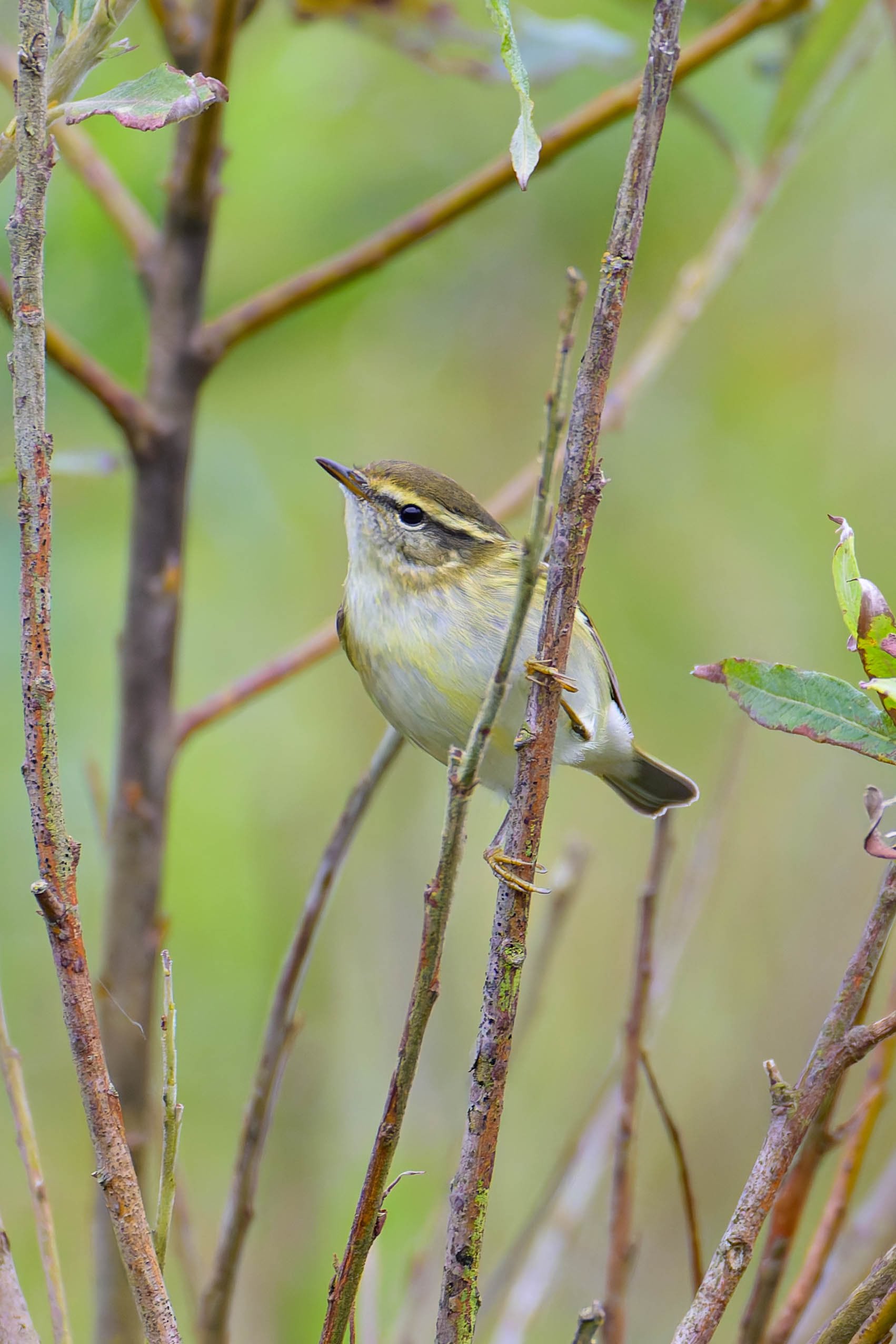
Migrants were scarce, but we did have sightings of Blackcap, Lesser whitethroat.

2 Great northern divers were also seen at Scousburgh.
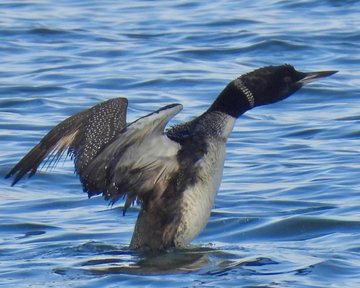
This morning was spent again around the south of the mainland at Sumburgh and Grutness, which was very quiet again, two Blackcaps were seen and 4 Yellow-browed warblers. News broke late morning that a Pallas's grasshopper warbler had been found at Garth further north, so we headed there. The bird eventually showed really well and this was my third for Britain, the bird didn't let us down and performed well to the crowd, sitting up at times in the low vegetation.
After cracking views of the bird, we made our way to Kergord where we connected with an Olive backed pipit which showed really well. The bird was foraging in low vegetation and then it flew up into a tree.
The wind had clearly changed by late afternoon and gone from a south-easterly to a westerly. News came out just before dusk that an Arctic warbler was showing well south of Lerwick so we headed there and got great views.
Another great day's birding on Shetland!
This morning was spent around the west side of the mainland. Few migrant birds were seen after a full day's birding,6 Blackcaps,8 Yellow browed Warblers and a Siberian Chiffchaff.
Siberian Chiffchaff
The wind has really picked up this afternoon, which has made finding birds very challenging, but before dusk, we connected with a returning Juvenile White Fronted Goose and Loch of Spiggie with Pink-footed Geese.
Spent this morning in the accommodation as I was having a Microsoft Teams interview online, so the other lads headed out. During my interview, news broke that a Common Nighthawk had been flushed by the side of the road on the island of Yell. Panic set in as I needed this for Britain, so after my interview I headed down to the airport to rent a car for the day and headed north. As I arrived at the ferry terminal at Toft, news broke that the bird was a Nightjar! Unbelievable. Earlier in the day, a Pallas's Warbler had been found so I headed there and got great views of the bird.
Pallas's Leaf Warbler
The weather was dreadful today a strong northerly wind and torrential rain. News broke that a Bluethroat had been found at Channerwick so we headed there and got good views.
The afternoon was spent birding from the car due to the weather, but we did manage to see a Lapland Bunting by the side of the road, which did show really well.
The weather eventually improved by the evening and we were all treated to amazing views of the Northern lights.
Waking up this morning, a pale-morph juvenile Booted Eagle over Nanquidno in Cornwall had been seen yesterday.
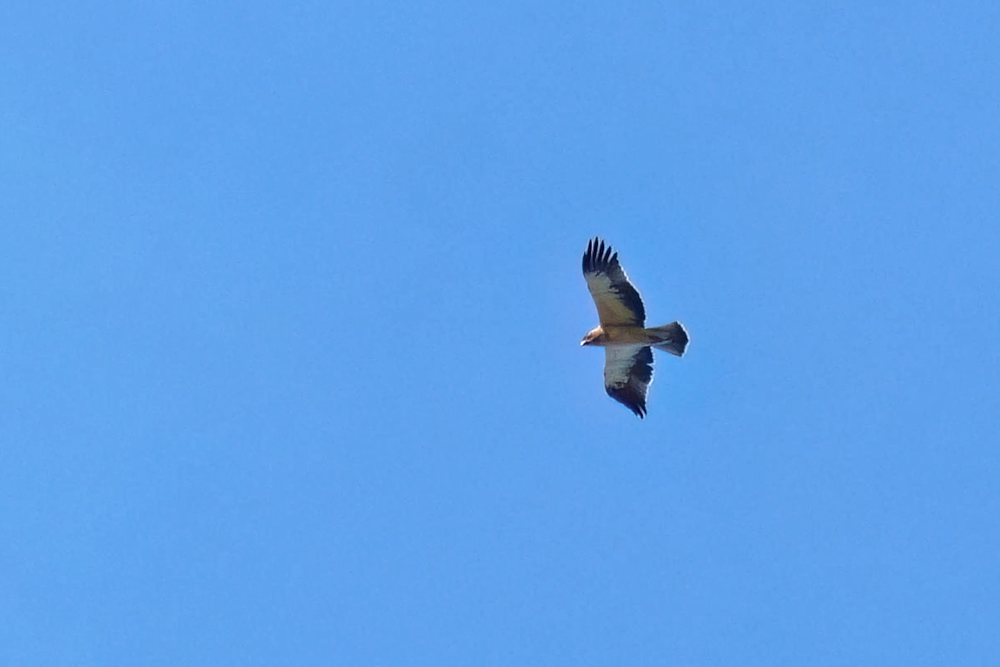
Botted Eagle (Jim Waterman)
After dark morphs over Cape Cornwall on the 20th May and Nanquidno on the 2nd September, both would fail to be seen again. Myself and Dan Pointon were up for leaving Shetland today if the bird was seen again so we carried on with our day.
A Cattle Egret was seen during the morning, with two Purple sandpipers, which all showed well.
Cattle Egret
News then broke late morning that the Botted Eagle had been relocated by some local birders showing on-and-off in the vicinity of Land's End until a final sighting at 1.45 pm. We booked our flights for a late afternoon departure back onto the mainland, we had to give it a go even though there was no sighting after 1.45pm. We headed back to our accommodation to pack and then just as we were leaving news broke that a White Winged Scoter had been found north of Lerwick. A quick drive north and we soon found the bird that was showing with a group of Eider.
White Winged Scoter
After good views of the bird, we headed for the airport and we were off after a great week's birding on Shetland!
11th Oct
After leaving Shetland yesterday afternoon with the news that the Booted Eagle was still around, Dan Pointon and I headed south and picked Owen Parsons up from Cheshire on our way down. We drove through the night and arrived on site just before 8:00 a.m., where we managed to find a good vantage point for the bird if it was still around.
We waited all day, but there was no sign of the bird. Plenty of Buzzards, a Red Kite, a Marsh Harrier, and a Merlin were seen. Good numbers of large Shearwaters passed, and Cory's and Manx were seen at Pendeen before dusk.
This was the third record from Cornwall this year, but none of them have hung around. The Booted Eagle has a controversial history in Britain and Ireland, with a pale-morph immature that toured Britain and Ireland in 1999-2000 currently placed into Category D – a holding category for species where there is a reasonable doubt that birds have occurred in Britain in a natural state – owing to anomalies such as the arrival date, duration of stay and state of plumage, as well as the largely unfounded accusation that the species isn't prone to crossing large bodies of water.
We decided to stay overnight in Penzance and hang around tomorrow just in case the bird made another appearance. However, by lunchtime, we gave up and headed to the Lizard, where we got good views of a juvenile Rose-Coloured Starling.
Back down the road at Helston, two Firecrests were seen and a Mediterranean gull was on the boating lake.
With still no news on the Booted Eagle we started the long journey back north and called in at Dawlish Warren where we connected with a male, female and two juvenile Cirl Buntings. I hadn't seen one of these for years and we ended up getting great views of them feeding on the golf course.
Dan and Owen photographing the Cirls
As dusk was upon us again we headed home, No Booted but THEY'LL BE ANOTHER!😎
2nd Nov
News broke this morning that a dark-morph Booted eagle had been seen two days ago at a work volunteer party by Alan Lewis https://www.birdguides.com/articles/rarity-finders-booted-eagle-in-the-chilterns/ and it had been refound again a few miles away by Chris Heard today. It was too late to travel down, so I made arrangements to meet Dan Pointon in the morning.
Having missed the pale-morph Booted Eagle in Cornwall a few weeks ago I hoped this bird was still about in the morning.https://saturdaycatbird.blogspot.com/2024/10/booted-it-for-booted-but-no-sign.html
I met up with Dan just after 7.00am and we drove to the east of Warburg NR where the Booted eagle had been originally found, finder Alan Lewis was already on site looking. A good number of Red Kites and Common Buzzards were seen but little else.
Red Kites loafing around in the fields
We headed towards Remenham Hill next and pulled up in a layby looking over where the bird had been seen yesterday, there were so many Red Kites in the area, we had already counted over seventy birds before 9.00am. Just after 9.30am, we were looking north towards Remenham Hill when Dan called out, I've got it, I managed to get on it, but it was constantly being mobbed by Red kites and as Dan rang the bird out to other birders, the Booted Eagle went down into the woodland. Ash Howe, Simon King and James Hanlon had now turned up as they were only down the road and it wasn't long before the Booted Eagle came out of the woodland and headed towards us being mobbed by Corvids.
Booted Eagle (C)Simon King
We all got great views of the bird before it eventually headed back towards the hillside and went down again, what a bird, and we were so lucky how close it flew towards us.
We headed over the other side of the Thames after this to try and get more views of the bird, but it was picked up flying east over Henley, so we only managed distant scope views.
Birders on site
6th Nov
Sat at home this morning, news came out that County recorder Jane Turner had caught a Barred Warbler in her garden at Hoylake. Jane put on the local WhatsApp bird group that the bird would be released in an hours time, so I made my way up to Jane's house.
Jane's seafront garden
Jane soon appeared from her garden with the bird in hand. A great bird for Cheshire and Wirral and a county tick for me having spent hours looking for the Burton bird last year.
11th Nov
News broke yesterday that a Penduline Tit had been found at Woolston Eyes in Warrington but due to family commitments, id have to wait till the morning. News came out early that the bird was still there, so I headed over there with Owen Parsons. Arriving on site, the bird hadn't been seen for over an hour but we didn't have to wait long before it was refound in the east corner.
Woolston Eyes Number 4 Bed
The Penduline Tit was found feeding on typha and showed well eventually.
(C) Dan Owen
Birders On Site
This was Cheshire And Wirral's third record after one was found at Woolston Eyes in 2022. What a week, Barred Warbler and Penduline Tit for the Cheshire life list!
Previous Records
Meols-Wirral-14th September 1986
Woolston Eyes-Warrington-12th November 2022-Refound on the 22nd -23rd November 2022
13th Nov
News broke late on Sunday after a homeowner photographed a strange yellow-and-black bird on their washing line, the photographs were posted on Facebook.
The bird was a Scarlet Tanager, a first-winter male, and it transpired that it had been present since the start of the week. News then broke on where the bird was, a place called Shelf in West Yorkshire.
I was at work on Monday so had to wait until Tuesday to visit the site. I woke up Monday morning, and while at work the news broke that the Scarlet Tanager had been found again. The bird was present all day, and the WhatsApp groups were gripping me off of photographs of the bird!
In 2011, I had left the Isles Of Scilly whilst on holiday for a Scarlet Tanager that had been found in Cornwall(See below), only for the bird not to be there and end up the next day back on the Isles Of Scilly, this bird species had already given me the run around!

St Levan, Cornwall, first-winter male,20th to 21st October 2011

Isles Of Scilly, Sandy Lane, St Mary's,first-winter male,22nd October 2011
Anyway, what I wasn't expecting was the sheer number of birders on site for this bird on a Tuesday morning when I arrived, after apparently 400 people had been on site yesterday, does nobody work anymore?
7.15am in the morning!
The main area where the bird had been seen yesterday
This was going to be a nightmare and so it proved when the bird was seen further down the road in a tree, briefly just before 8.00am by a few birders. everybody surged forward, but the bird had gone straight through. The bird was seen again just before 9.00am down the side of a house, where the bird perched up in a cherry tree for a few seconds, again, you had to be in the right place to see the bird due to the size of the crowd.
Birders On Site
The rest of the day was uneventful with no sightings of the bird before dusk. I was still hopeful the bird was around so I headed home and decided I would come back in the morning and hopefully the crowds would be gone! A few phone calls and texts had me laughing during the evening, that I had been seen on the regional news and even made the ITV news at 10.00!
I arrived back on site at 7.00am and thankfully there were only a few people on site but again there was no sign of the bird by 9.00am so I teamed up with the remaining birders and did some door knocking on the top road looking down on the area I had been looking up at yesterday. Thankfully, a lovely lady called Mavis let us into her garden and we were in prime position if the bird showed again.
Mavis's garden overlooked the area where the Scarlet Tanager had been regularly seen over the last week, after talking to a few of Mavis's neighbours
We waited and waited, hopeful that the bird would return and as birders decided to leave, due to Sparrowhawk theories and that it had gone, I decided to give it till dusk, there were only eight of us left! At 2.30pm I was walking down the garden when Dave Woodhouse shouted "Al, it's in the tree", unbelievable after 15 and a half hours of standing around I was actually now watching this MEGA YANK! No pushing, No Scrum, just eight of us watching this bird in total silence taking it all in!AMAZING!
First photographs of the Scarlet Tanager
The Tanager continued to show well and the birders that had left started to return to get crippling views of the bird.
Me and Dave Woodhouse, Dave had been on site since yesterday morning as well! Dedication and patience had finally paid off!
IMAGES AND VIDEO OF THE SCARLET TANAGER!
9th Nov
I've spent the last few days in the county of Caithness up in Scotland and saw some good birds on my travels. On the way up north I called in at Newshot Island in Clyde where I connected with an American Wigeon which I needed for my Scottish life list.
American Wigeon
Staying in Thurso, a good selection of birds were seen.

Long Tailed Duck
Sanderling
Ringed Plover
Wigeon
Other birds of note were Black guillimot, Eider and Red-throated Diver. I visited Broubster Leans RSPB whilst in Caithness, which was a new site for me, where I saw good numbers of wintering Whooper swans and Greenland white fronted geese.
 Broubster Leans RSPB
Broubster Leans RSPBGreenland White Fronted Goose
Whooper Swan
On the way home I called in at a few sites where I saw some good birds and added another Scottish lifer to my life list.
Kumlien's gull at Helmsdale-Highland

Loch Fleet-Highland
Green-winged Teal- A new bird for my Scottish life list
Dornoch beach-Highland
Surf Scoter
2 Surf scoter were seen with a flock of 600 Common Scoter, Slavonian Grebe and a Red-throated Diver
A great few days away birding!
12th Dec
I visited East Chevington today as my friend Owen Parsons needed Grey-headed lapwing and asked if I would like to go up with him, as he had missed the bird in 2023. We spent the day there, but no sign. We did a seawatch whilst on site and were rewarded with good views of Common scoter, Velvet scoter, two Surf scoters and a Black throated diver
Surf Scoter
Other birds of note were
Russian White Fronted Goose
Kingfisher
28th Dec
News broke today that a Yellow warbler had been found in Kent, of all the days, Christmas Eve. I toyed with the idea but I had far too many family commitments tomorrow, Boxing Day for me. The bird was still present on Christmas day, so I made my way down to Kent for first light this morning.
Birders On Site
The bird showed briefly twice when I arrived and even heard it call on a couple of occasions from the other side of the stream, but I was standing in the wrong place. There was no sign of the bird after a three-hour wait, but a Firecrest showed well and kept the crowd entertained for a few hours.
After the long wait, a birder called out that he had the bird and the Yellow warbler eventually flew up into its favoured alder trees and put on a top class performance for the masses.
What a bird, at last I had caught up with this little stunner. I missed the Portland, Dorset bird in 2017 by one day and then ended my holiday in 2023 on Shetland and one turned up the next day. What a couple of weeks for Yank warblers, gripped back this and a Scarlet tanager, what a Year!





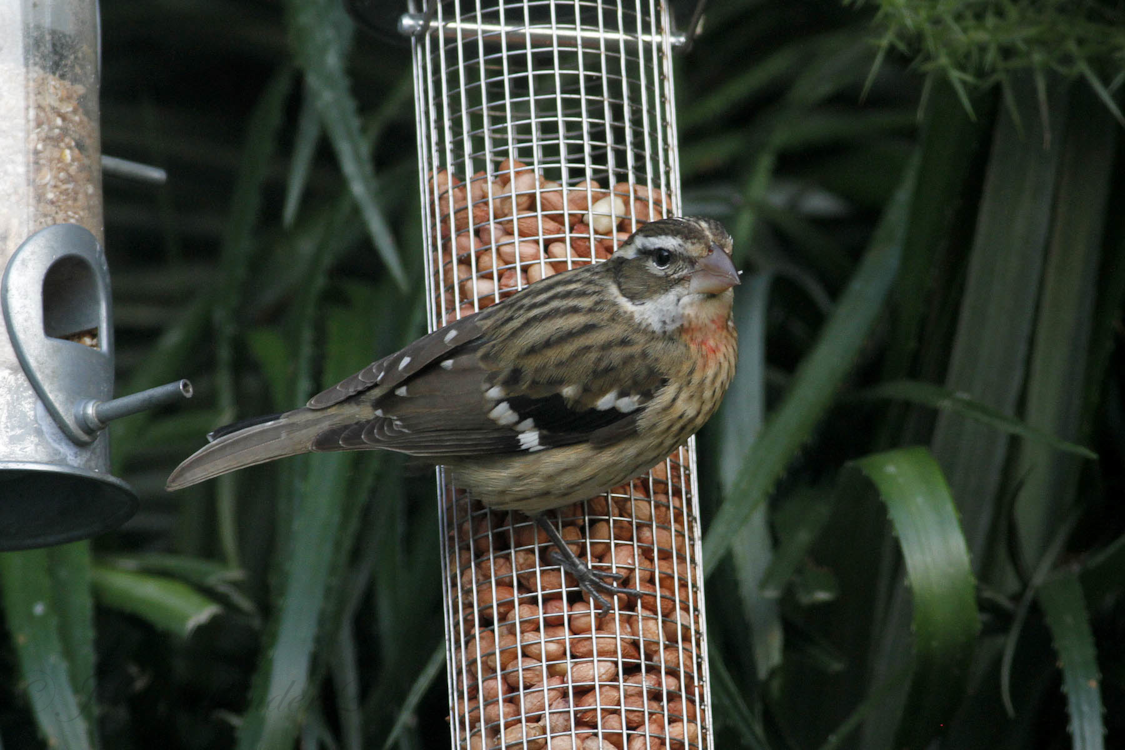
 Indigo Bunting
Indigo Bunting
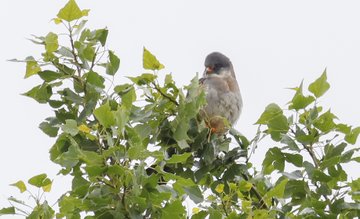


 Acre Nook bird
Acre Nook bird



 Pennington Flash Bird 2002
Pennington Flash Bird 2002







